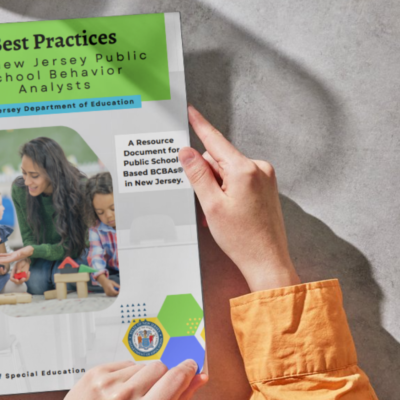
Imagine you’re a behavior analyst navigating the unique challenges of working in a public school. From completing assessments and designing behavior support plans to consulting with teachers and parents, the role is diverse and demanding.
Or perhaps you are a school administrator who wants to learn more about behavior analysts’ scope of practice and how to maximize the effectiveness of your behavior analytic team. Behavior analysts add invaluable expertise to impact student achievement, and careful planning of their roles and responsibilities within the district can produce the greatest benefit.

Developed in collaboration with an advisory committee of behavior analysts who work in schools, this resource offers tailored guidance to enhance student learning and behavioral outcomes. Standards aligned with the unique practice of behavior analysis within New Jersey’s public schools are outlined, emphasizing the significance of individualized student support, systems-level impact, data-driven decision-making, and collaboration with educational teams to foster positive behavioral changes.
“While working in public schools I have seen the opportunities and challenges that arise as behavior analysts navigate complex situations. Creating a shared understanding of the behavior analyst’s role can help teams work together to positively impact both individual students and school systems. This document provides clear guidance to lay that foundation,” Amy Golden, M.S., BCBA, LBA, NBC-HWC, Autism New Jersey’s Director of Family Wellness, former public school behavior analyst, and DOE BCBA Advisory Panel Member.
Read the document’s major sections and recommendations summarized below.
Defining Roles and Responsibilities of School-Based Behavior Analyst
Behavior analysts in public schools often serve in multiple roles and have varied responsibilities depending on each’s districts needs and goals, as well as the needs of individual students. Some of these roles may include:
- Program Development: Designing and evaluating behavior support programs to ensure they meet students’ needs.
- Consultation: Advising teachers, administrators, and parents on behavioral strategies and interventions.
- Training and Supervision: Educating school staff and overseeing the implementation of behavior analytic services.
- Small Group Interventions: Working with small groups of students on social skills or behavior management programs.
- Intensive Individualized Supports: Working one-on-one with students to implement behavior intervention plans.
- Crisis Intervention and Behavior Supports: Providing training and guidance on maintaining a safe and supportive environment.
By delineating all of the ways behavior analysts can provide expertise in the school setting, teams can clarify priorities to meet the needs of each school. This is important because behavior analysts are easily pulled in many directions and have to carefully manage their time to help with various tasks, as well as unexpected issues that arise.
Identifying the Client
The document clarifies that while the student is the primary client, behavior analysts must also consider the needs and perspectives of other stakeholders, including parents, teachers, and the school community. This holistic approach ensures comprehensive support for the student’s development. Behavior analysts work on multidisciplinary teams and need to effectively collaborate with all individuals involved with the student when planning and implementing various strategies. This collaboration requires that behavior analysts learn about strategies within and beyond ABA, as well as gain a clear understanding of each family’s priorities and values.
Outlining Standards of Practice
The publication summarizes standards that align with various service models, roles, and client interactions. Practices specific to direct or indirect services, foundations of service delivery, and those that apply to all services are outlined. These standards guide behavior analysts in maintaining professionalism, ensuring ethical practice, and delivering effective behavior analytic services within the school setting.
Providing a Best Practices Framework
Examples of best practices for school-based behavior analysts are provided, including:
- Assessment: Conducting thorough evaluations to identify student needs and inform intervention strategies.
- Intervention: Implementing evidence-based strategies tailored to individual students.
- Data Collection and Analysis: Systematically gathering and analyzing data to monitor progress and adjust interventions as needed.
- Collaboration: Working effectively with educators, families, and other professionals to promote consistency and generalization of behavioral interventions to support student success.
- Social-Emotional and Behavioral Health Integration: Prioritizing the holistic development of students’ well-being through interprofessional collaboration and supports.
- Professional Competence and Integrity: Engaging in ongoing learning to stay current with advancements in the field of behavior analysis and adhering to legal and ethical guidelines.
- Cultural Competence: Advocating for sensitivity to and respect for cultural and individual differences when designing and implementing interventions.
Optimizing Use of School-Based Behavior Analytic Services
It is not unusual for behavior analysts’ caseloads to be quite large and across different programs or schools, so it can be a balancing act to provide support everywhere it is needed. This document outlines considerations for the optimal allocation of behavior analyst services within a district. Clarifying roles, establishing a reasonable caseload/workload, and supporting the behavior analyst’s professional development are all considered important for the most effective use of these services. Taking some time to review this information can help behavior analysts and administrators establish a shared understanding and align strategies to provide support across the district.
Using this Guide and the Autism Program Quality Indicators-Revised
This resource serves as a valuable tool for behavior analysts in New Jersey’s public schools, providing a structured approach to delivering high-quality behavior analytic services. Additionally, the guidance provides administrators with detailed information to help plan for effective service delivery. By adhering to these best practices, behavior analysts can effectively contribute to positive educational outcomes for students across the state.
In 2023, the DOE released the Autism Program Quality Indicators-Revised (APQI-R), a self-assessment and quality improvement guide for school-based programs serving autistic youth. The extensive document outlines evidence-based practices for effective instruction across the range of educational settings within a district. Districts can use this self-assessment to evaluate and improve existing programs.
Some districts have already been creating APQI-R implementation teams, which include behavior analysts, administrators, and other key school personnel. These teams are coming together in a structured way to self-assess, review the guidelines, and make recommendations to improve the outcomes for students with autism. By developing both the Best Practices for New Jersey Public School Behavior Analysts and the APQI-R, the DOE has equipped schools with two comprehensive tools to coordinate efforts and maximize student progress.








